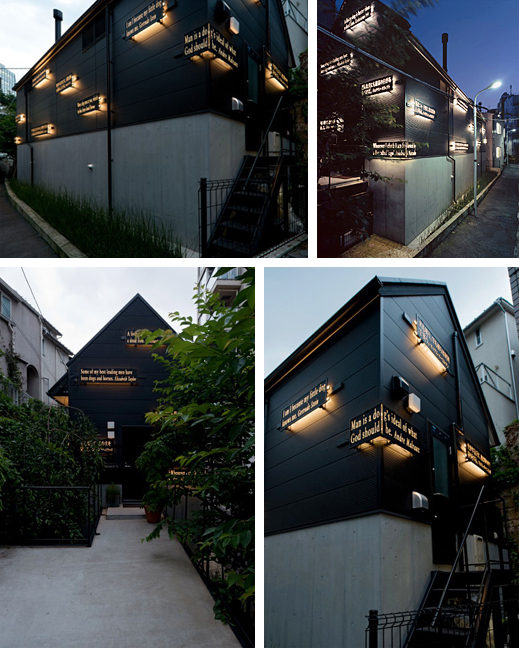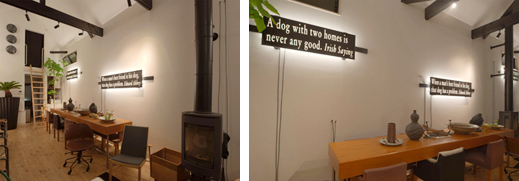 |
Focus features two in-depth reviews each month of fine art, architecture and design exhibitions and events at art museums, galleries and alternative spaces around Japan. The contributors are non-Japanese art critics living in Japan. |
|
|
 |
 |
 |
A Work of Love: The Dog House by Joseph Kosuth
Lucy Birmingham |
 |
 |
Artist Joseph Kosuth standing in front of
The Dog House (2012, Venetian glass,
rare wood, concrete and other materials) |
A doghouse can be paradise -- if, of course, it is "The Dog House" designed and adorned with works by the "godfather of conceptual art," Joseph Kosuth. All the more so if it is owned by Joni Waka, the renowned and controversial Tokyo-based art patron. And, if it was inspired by the late Francis Bacon. No, not the famed Irish-born 20th-century figurative painter, but the very large Irish wolfhound (100 kilograms, 2 meters long, 1.5 meters tall) owned by Waka. Born in Hungary, "Bacon" became a mascot of the Tokyo art world during his short life in the mid-2000s.
The Dog House was completed in May this year and is located in a quiet urban valley about five minutes' walk from Tokyo's bustling Shibuya station. Shaped like a giant doghouse, the building contains 21 neon elements displayed on the interior and exterior walls. Each work was made by hand in Venice to precisely fit the building's shape and wall colors; Venetian glass was used for the neon tubing. Despite the many technical, electrical, and delivery challenges involved, Kosuth's perfectionism reigned throughout the creation process, from conception to construction.
This contemporary structure/artwork serves as Waka's home and workspace, and as a short-term residence for international artists. A dedicated dog lover, Waka says it is a "work of love . . . a Taj Mahal for a dog." For word artist Kosuth, The Dog House is a culmination of his four decades of art practice. It combines a new direction -- his first building design -- with a revival of his iconic neon tautologies: artwork with words in neon that describe or reference the artwork itself.
 |
Exterior views of The Dog House by Joseph Kosuth (2012)
|
Among Kosuth's best-known tautologies is Five Words in Five Colors (1965). The statement is precisely that: those five words, each in a different neon color. Like The Dog House, the work's simple presentation belies its complexity. Packed out of sight is a lengthy discourse on the essence of conceptual art. More cerebral than visual, his works explore the meaning, presentation, and purpose of art.
Lauded as both artist and theoretician, Kosuth often uses quotations by renowned intellectuals. The philosopher Ludwig Wittgenstein and conceptual artist Marcel Duchamp are favorites. For The Dog House he has chosen quotes entirely about dogs, in English and Japanese, by such personalities as Nietzsche ("Whenever I climb I am followed by a dog called 'Ego'"), Gertrude Stein ("I am because my little dog knows me"), and Andre Malraux ("Man is a dog's ideal of what God should be"). Even Elizabeth Taylor has her say at the front entrance with "Some of my best leading men have been dogs and horses." My personal favorite is by Franz Kafka: "All knowledge, the totality of all questions and all answers, is contained in the dog."
The neon, says Kosuth, gives the work a tension that he likes: it drapes the seriousness of the work in a "light" public street medium. This may help lighten his message, and yet Kosuth has built his reputation as a heavy in the art world. His blatant and biting criticism of his contemporaries has engendered equally derisive criticism in return, but also considerable respect. He has garnered numerous awards, including the Decoration of Honour in Gold for Services to the Republic of Austria, and has even been commemorated on a French postage stamp. His works are exhibited in many of the world's finest museums and galleries.
 |
Interior views of The Dog House by Joseph Kosuth (2012)
(All images © Peter Cook; courtesy of the photographer)
|
For both fans and foes, The Dog House is a surprise -- not just for its newness, but for its display of Kosuth's sense of humor. Sure enough, behind the weighty messages and grumpy assaults, there is joy in irony, compassion, and remarkable generosity.
The birth of The Dog House is a case in point. It began with the death of Waka's Irish wolfhound, Bacon, in the summer of 2008. Bacon succumbed to a heart attack during a trip along the Japanese seashore with Waka, Kosuth, and his two daughters. Kosuth was moved by Waka's quiet grief and affection for the dog. He also felt a special affinity with Bacon due to their mutual Hungarian roots. The artist volunteered to design the building and produce the installation as a memorial to Bacon and a "thank you" to Waka for his many years of contribution to culture and the arts in Japan.
The Dog House has been a widely collaborative effort with technical support from architects Claudia Hertrich and Ryo Shimizu; contributions by artists Seamus Farrell, Ryan Peterson, and Noema Kosuth; and the expertise of Suzuwa Construction Co., known for its long history of building sento (public bath houses) using traditional Japanese joinery and rare woods.
The Dog House is now permanent public art. The property exterior is registered as an official Shibuya Ward park and is open to anyone for viewing. The interior is also available for viewing, but by appointment only.
|
|
|
 |
The Dog House |
 |
Contact information:
A.R.T.
The Dog House
17-9 Uguisudani-cho, Shibuya-ku, Tokyo 150-0032
Email: arttokyo@me.com
|
 |
|
 |
|
|
|
 |
 |
Lucy Birmingham
Based in Japan for over 25 years, Lucy Birmingham is TIME magazine's Tokyo-based reporter. Her articles have also appeared in numerous Japanese and international publications and websites includingArchitectural Digest, Bloomberg News, Newsweek, Time.com, Wall Street Journal Asia, The Boston Globe, Artinfo.com, Artforum.com, and ARTnews. As a photojournalist her work has appeared in The New York Times, Business Week, Forbes, Fortune, U.S. News and World Report, and A Day in the Life of Japan. She is also a scriptwriter and contributing editor at NHK, Japan's public broadcaster, and has published several books including Old Kyoto: A Guide to Traditional Shops, Restaurants, and Inns. |
|
 |
|